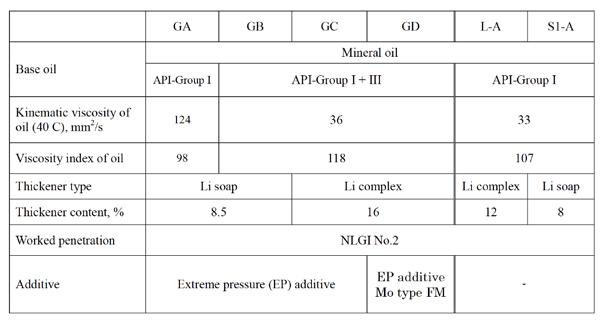
20 minute read
Influence of Grease Components on Energy-Saving Performance
SAKAI Kazumi*, AYAME Yusuke, SAKAMOTO Kiyomi, SHITARA Yuji
Lubricants R&D Dept., JXTG Nippon Oil & Energy Corporation 8, Chidori-cho, Naka-ku, Yokohama 231-0815, Japan *Corresponding author: sakai.kazumi@jxtg.com
Abstract
The energy-saving performance of greases has become more and more important for rolling element bearing applications. This study focused on the lithium-type greases widely used all around the world, and investigated the influence of grease components through measurements of the power consumption using real bearings. Regarding thickener types, lithium complex grease was effective in the reduction of power consumption. The mechanisms of the low power consumption were proposed based on the measurements of grease film thickness using an optical interferometry method and friction properties using an MTM (Mini Traction Machine) device. The results suggest the importance of the thickener entrainment in the contact and the grease movement around the contact.
Keywords: grease, energy-saving, EHL, film thickness, lubricants, bearing
1. Introduction
Recently, the development of lubricants has greatly focused on their energy-saving performance in order to reduce CO 2 emissions. Greases are used for lubrication of more than 90% of rolling element bearings [1] . Therefore, in the case of greases, the development trend is to reduce bearing energy consumption such as the bearing torque.
The concept of energy-saving formulations for engine oils can be applicable to the grease development. Regarding base oils, the use of lower viscosity base oil contributes to the reduction of stirring resistance of grease within the bearing. The chemical structure of base oils influences the friction. The base oil with linear shaped molecules such as PAO (polyalphaolefin) provides lower friction coefficient, and therefore, is effective in the reduction of the sliding resistance. The selection of additives is also important for reducing friction. For instance, the friction modifier represented as an organic molybdenum (Mo) compound can reduce the friction coefficient in a reciprocating tribotester.
In addition, greases are semisolid due to thickeners, and therefore, the mechanical energy loss due to friction in a greased bearing is not consistent. The change of mechanical energy loss can be explained by churning and channeling phases. In the initial stage of the bearing operation, the grease is sheared by the moving parts, and this causes high bearing torque (or temperature increase) due to the drag losses [2, 3] . This is called the churning phase. After that, most of the grease is pushed away from the running track. Due to this grease clearing, the drag losses from grease shearing decrease. As a result, the bearing torque reaches at a steady low value, and this is called the channeling phase. The selection of thickener is essential to promote the quick transition from grease churning to grease channeling in the bearing operation. Sakai and co-authors [4, 5] investigated the effect of base oil and thickener types on radial ball bearing torque for lithium-type greases. The fluorescence technique was introduced for
the observation of grease flow behaviors around an elastohydrodynamic lubrication (EHL) contact area. Grease rheological parameters and film thickness were also measured for the discussion of the bearing torque. The grease thickener effect on the film thickness was studied in order to understand the influence of surface conditions [6, 7] .
In this study, the energy savings by greased bearings were investigated using an original power consumption measurement device, consisting of a motor, two pairs of bearings with sample greases, and a watt meter. The influence of base oils, thickeners, and additives in greases on the power consumption of the bearing was studied. This study also focused on the thickener type, and the grease properties such as rheology, friction, and film thickness were studied in order to understand the causes of the differences of the power consumption.
2. Experimental methods
2.1. Grease samples The greases (GA, GB, GC, and GD) used in this study consisted of different mineral base oils, thickeners, and additives as shown in Table 1. The mineral base oils had different kinematic viscosities and viscosity indexes. The thickeners were lithium (Li) type, simple Li soap and Li complex, leaders in worldwide sales by grease type [8] . Phosphorous- and sulfur-type extreme pressure (EP) additives and a molybdenum (Mo) friction modifier (FM) additive were investigated. To focus on the influence of the thickener type, greases without additives were also used, L-A and S1-A in Table 1. The tested greases were prepared through the saponification reaction between fatty acids and lithium hydroxide under the atmospheric conditions. Table 1. Grease formulations.
2.2. Power consumption The energy-saving performance of test greases was determined by using an original power consumption measurement device as shown in Fig. 1. Two pairs of bearings with test grease were connected with a motor via a v-belt. While the bearings were rotated for two hours, the amount of the power consumption of the motor was measured. The setups of the two pairs of bearings were adopted for increasing the total load and obtaining the reliable power consumption values. Two types
of bearings (with the same bearing diameter) were used in this study in order to understand the dependence of bearing type. One bearing type was 7008ADF, double row ball bearing, and the other bearing type was 4T-CRI-0868, double row roller bearing.
Figure 1. Schematic image of equipment for power consumption measurement.
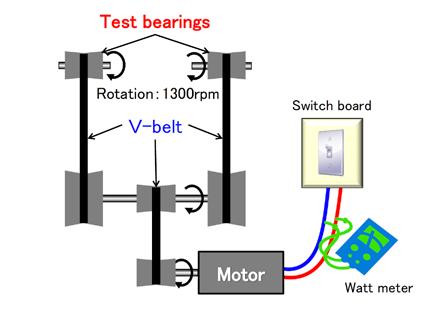
2.3. Rheology The apparent viscosity of each of the greases at a shear rate from 0.1 to 2000 s -1 was determined by using a cone-plate type of rotational viscometer (HAAKE Viscometer 550). First, the viscosity was measured while increasing the shear rate, and then the measurement was continued while decreasing the shear rates in order to understand the influence of the shear history. The cone was 20 mm in diameter and had an angle of 1 degree. Measurements of the yield stress of each grease were conducted with a parallel-plate type of rheometer (HAAKE MARS III), using viscoelastic parameters. The diameter of the two plates was 25 mm, and the frequency was 1 Hz. The storage modulus (G’), the loss modulus (G’’), and shear stress were measured while the deformation was controlled from 0.01 to 100%. The yield stress was defined as the lowest shear stress when G’’ was greater than G’.
2.4. Friction property Friction coefficients were measured using a ball-on-disk tribometer, a PCS Instruments Mini Traction Machine (MTM). An AISI 52100 steel ball with diameter of 3/4 in. and a disk of the same material were selected as the standard specimens. The RMS roughness values of ball and disk were about 6 and 10 nm, respectively. The maximum Hertzian pressure was 0.65 GPa. A scoop was used for maintaining fully flooded conditions during the friction tests. Conditions without the scoop were also evaluated. Tests were conducted at ambient temperature. The velocity range between 0.1 and 3 m/s was selected for these tests. For the slide roll ratio (SRR), 0.03 was selected as representing the typical SRR range found in rolling bearings.
2.5. Thickener structure Grease thickener fiber structures were observed by TEM (Transmission Electron Microscope). The oil component was removed from each grease with n-hexane solvent, and the residual thickener components were observed by TEM (JEOL JEM-2010). Acceleration voltage was 200 kV.
2.6. Film thickness Grease and oil film thicknesses were measured by using the colorimetric interferometry technique [9] . The film thickness formed between a glass disk and a steel ball was observed. The contact images were captured by a digital camera. The film thickness was calculated from the interferograms based on colorimetric analysis using a color-matching algorithm and CIELAB color film thickness calibration.
Balls for film thickness measurements in the optical interferometry tests were AISI 52100 steel balls with the diameter of 25.4 mm and the surface roughness RMS of about 15 nm. The elastic modulus and the Poisson’s ratio of the steel ball were 210 GPa and 0.3, respectively. A BK7 glass disk with optically smooth surface was used. The elastic modulus and the Poisson’s ratio of the glass disk were 81 GPa and 0.208, respectively. The bottom surface of the glass disk was coated with a thin, reflective chromium layer, and the top of the disk was coated with an antireflective layer. The load used for film thickness measurements was 27 N, and the maximum Hertzian pressure of the contact was 0.43 GPa for the smooth ball-on-disk contact. A v-shaped scoop was used for pushing the grease from the side of the track back to the running track in order to maintain fully flooded conditions. The film thickness observations were conducted as the velocity was increased from 0.01 to 1 m/s under nominally pure rolling conditions and 22 C. The disk was driven and the ball was followed for the smooth ball-ondisk contact. The observed film thickness for greases fluctuated due to the entrainment of thickener particles. Therefore, the average thickness values of the central circular area with a diameter of 100 μm was selected for central film thickness. In addition, the central film thickness values were averaged from the results of 5 captured images.
After the film thickness measurements at each velocity under fully flooded conditions, the grease flow patterns created downstream of the contact on the disk were observed.
In order to observe the grease film thickness decay under starved conditions, film thickness measurements without the scoop were conducted for the smooth surface contact. The contact images were captured as the velocity was increased by 0.024 m/s every 30 seconds.
3. Results and discussion
3.1. Energy-saving performance Figures 2 and 3 compare the power consumption of the motor connected with ball bearings and roller bearings, respectively. For both bearing types, the power consumption with GB was lower than that with GA, suggesting that lower viscosity base oil was related to less viscosity resistance. The effect of Li thickener type was also confirmed by the comparison of GB and GC. Li complex contributed to less power consumption with GC versus simple Li grease GB. The Li complex grease needed more thickener content for the same worked penetration compared with the simple Li soap grease. That difference could be one of the reasons of the lower power consumption of Li complex grease versus simple Li grease.
The additive effect of the Mo FM is shown by the difference between greases GC and GD. Comparing the bearing types, the effect of Li thickener type was larger in the ball bearings than in the roller bearings. In contrast, the Mo additive effect was larger in the roller bearings than the ball bearings. The energy loss due to the friction between the edge of the roller and the collar of the inner race of the bearing was larger in roller bearings, and therefore, the reduction of friction by the Mo additive provided the lower power consumption.
Focusing on the Li thickener type, the cause of the difference of power consumption will be discussed in the following section.
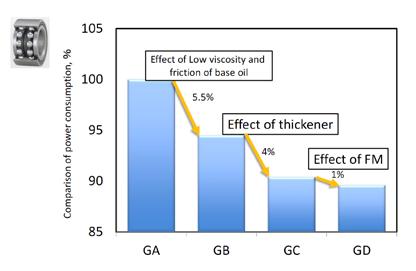
Figure 2. Power consumption in ball bearing tests.
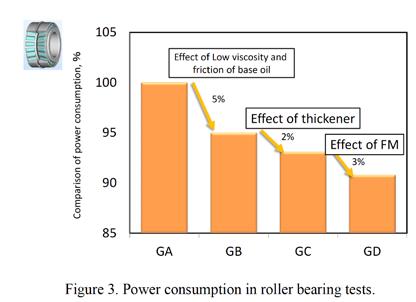
Figure 3. Power consumption in roller bearing tests.
3.2. Rheological parameter The shear rate dependence of the apparent viscosity for grease samples was measured. Figures 4 and 5 show the results for both increasing and decreasing shear rate conditions for the two greases. L-A and S1-A mean Li complex and Li soap thickeners, respectively. Viscosities measured while increasing the shear rate were higher than those measured while decreasing the shear rate for all the greases. The gap between viscosities measured while increasing and decreasing the shear rate differed by the thickener type. For instance, S1-A with Li simple soap showed a larger gap than L-A with Li complex thickener. The viscosity gap was observed when the grease was pushed away from under the when the shear rate was increased. This indicated that Li simple soap grease caused channeling quickly. However, the power consumption of Li simple soap grease was higher than Li complex grease. The viscosity gap cannot be used an indicator of grease channeling.
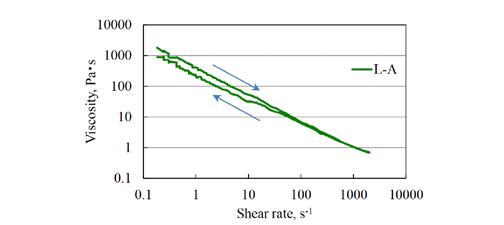
Figure 4. Apparent viscosity of L-A (Li complex) including high shear history.
Figure 5. Apparent viscosity of S1-A (Li soap) including high shear history.
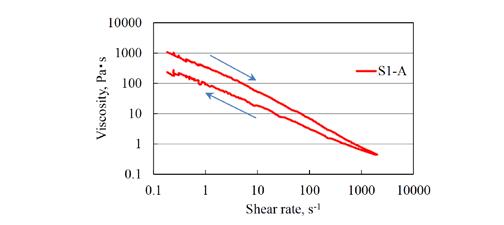
Figure 6 shows an example of viscoelasticity data of two greases. The yield stress is defined as the lowest shear stress when G’’ is greater than G’, and the results for the yield stresses of greases are summarized in Fig 7. Li soap (S1-A) showed the higher yield stress. This tendency could relate to the viscosity result, because higher yield stress grease did not lead to lower power consumption in bearings.
Figure 6. Viscoelasticity of L-A (left) and S1-A (right).

Figure 7. Yield stress of greases.
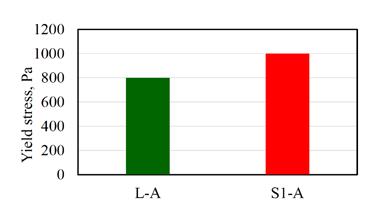
3.3. Friction property Friction was investigated using an MTM device. Figure 8 compares the velocity dependence of the friction coefficients of the greases and their base oil (API-Group I mineral oil, kinematic viscosity 33 mm 2 /s at 40 C, viscosity index 107, abbreviated ‘Oil A’ in Fig. 8) with 3% SRR. Without a scoop for maintaining fully flooded conditions, greases L-A and S1-A initially showed an increase in friction and then a decrease in friction as the velocity was increased. The friction increased again at higher velocity for L-A (Li complex). However, S1-A (Li soap) kept the constant friction at the high velocity region.
The base oil used for the greases (Oil A in Fig. 8) showed the almost constant friction values through the entire velocity range. The values of the friction for Oil A were close to the friction values of S1-A in the high velocity region.
In addition, the effect of the scoop at a fully flooded condition was also confirmed for L-A. With the scoop, L-A showed a stable friction coefficient close to the friction coefficient for the base oil. This result suggests that the friction properties of the grease depended on the base oil, at least under fully flooded conditions.
The friction increase for greases in the low velocity region could be related to the running-in process of the greases because both samples showed common behavior. At faster speeds, S1-A supplied the lubricant (only oil or grease itself) to the contact, and therefore the friction approached the friction of the base oil. On the contrary, L-A was not able to provide the lubricant to the contact in the high velocity region, and therefore the friction increased. This phenomenon could be related to the channeling in the bearing when it operated at high rotation speeds.
From the above discussion, the grease movement such as channeling seems to be related to the energy consumption of bearings. In order to understand the grease behaviors focused on the thickener type in detail, grease fiber structures and film thicknesses were investigated.
Figure 8. Velocity dependence of traction property.
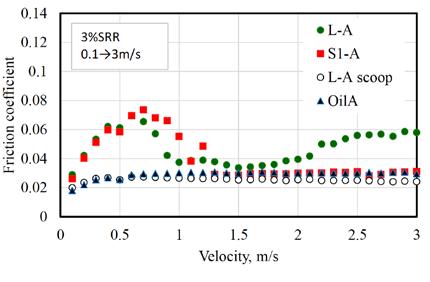
3.4. Thickener structure The thickener structures of greases were examined by TEM observation. Figure 9 compares the thickener structure of Li complex and Li simple soap. The thickeners formed fiber structures. The fiber shape of Li complex (L-A) appears thinner and longer. On the contrary, the fibers of Li soap (S1-A) seems thicker and shorter. The thickener shape of Li complex could be more effective than Li simple soap and better able to hold base oil, promoting grease channeling in bearings.
Figure 9. TEM images of grease thickener.
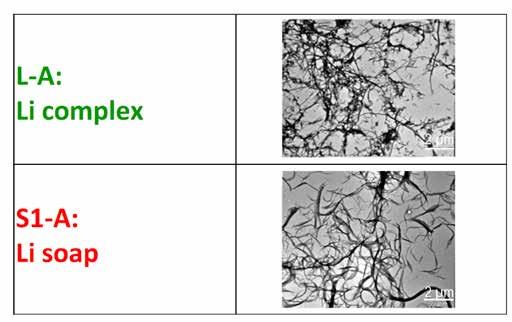
3.5. Film thickness Figure 10 compares the central film thicknesses for greases and base oil under fully flooded conditions. Regarding the low velocity region, Li complex grease (L-A) formed thicker films compared with those formed by the base oil itself (also referred to as Oil A), since the thickener particles were entrained in the contacts as shown in Fig. 11, observed interferometry images at 0.025 m/s. In contrast, film thickness values formed by Li soap grease (S1-A) were close to those of the base oil. At higher velocities, the dependency the film thicknesses on thickener types was less significant, although all the greases formed thicker films than the base oil.
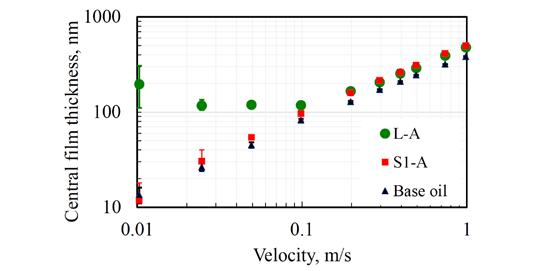
Figure 10. Central film thickness of greases and base oil under fully flooded condition.
Flow patterns created on the disk during film thickness measurements under fully flooded conditions were also investigated. Figure 12 compares the patterns at the low velocity of 0.025 m/s. These images show the contact track in the center and the flow patterns on both sides of the track. It was reported that the finger-like patterns are formed by the outlet cavity [10, 11] . The patterns were dependent on the thickener types in this study. L-A (Li complex) showed flow patterns stretching to the track. In contrast, the pattern formed by S1-A (Li soap) did not reach to the track. This difference can be recognized more clearly in the magnified images of L-A and S1-A. The color of the images is related to the thickness of the grease to some extent. However, it should be noted that the values of the thickness are not precise, because the interference data are not related to the separation between the steel ball and the glass disk but between the air and the disk. Although the interference colors do not show adequate quantitative values, it can be stated that brown and dark blue colors show thinner films, and green and purple show thicker films, and no colors (or grey) show much thicker films. For instance, in the flow pattern of the side track of L-A, there were alternating thick areas (without colors) and thin areas (with some colors). The thick area (without colors) was distributed to the near side of the track. In the case of the S1-A grease, the edge of the track was surrounded by the thin area (such as brown color). The difference should relate to the film thickness behaviors.
Figure 11. Interferometry images at 0.025 m/s.

Figure 12. Grease flow patterns at the downstream side of the contact at 0.025 m/s and magnified images of the zones shown in red rectangles.
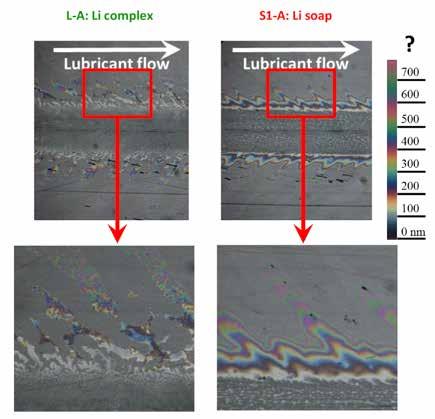
Figure 13 shows the grease film thickness transition with the velocity increase without a scoop under starved conditions. The film thickness for all the greases showed the transition to starvation between 0.2 and 0.4 m/s. In the low speed range just before the film thickness dropped, the film thickness values were similar to those under fully flooded conditions as shown in Fig. 10. The film decay of S1-A (Li soap) occurred earlier compared to L-A (Li complex). More frequent particle entrainments of L-A could contribute to the later starvation due to the more lubricant replenishment.
Figure 13. Central film thickness of greases under starved conditions.
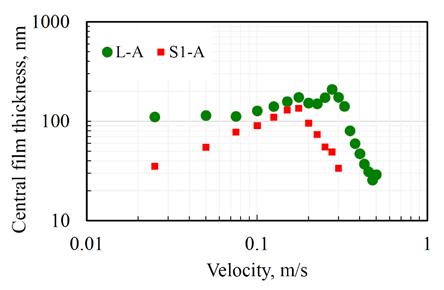
3.6. Correlation of grease properties The obtained results in this study are summarized in Table 2. The friction increase of Li complex grease that occurred in the high speed range indicated the grease channeling. The typical grease-like behavior was also observed for Li complex grease in the film thickness observations. The main reason for this behavior depended on the thickener particle entrainment in the contact area. On the contrary, for the Li simple soap grease, the thickener entrainment in the contact did not occur.
The thickener entrainment influenced not only the film thickness but also the flow patterns. Li complex grease showed flow patterns at the side track downstream of the contact. In contrast, Li simple soap thickener was not dragged into the contact, and therefore the edge of the track was also surrounded by thin area. For the film thickness measurement under starved conditions without using a scoop, the Li simple soap thickened grease caused quicker starvation. One of the reasons could be that the Li simple soap thickener was not dragged into the contact. Without thickener entrainment, there was less lubricant replenishment to the contact.
Comparing the power consumption results, the channeling effect of Li complex should contribute to the reduction of the grease stirring resistance in bearings as indicated in friction tests. In addition, the superior film formation of Li complex could assist the reduction of the power consumption.
4. Conclusions
The influences of base oil, lithium-type thickener, and Mo additive in grease on the power consumption of bearing operation were investigated in this study. The base oil with lower viscosity and lower friction, the Li complex thickener, and a Mo additive were effective in the reduction of power consumption.
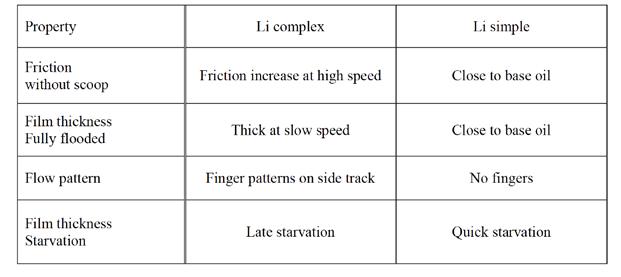
NLGI RESEARCH GRANT REPORT
Available to Members
Most recent report finalized by Louisiana State University

Summary & Full Reports Available
Login to the members’ only area to read the report today: https://www.nlgi.org/my-account/
The advantage of Li complex thickener was examined through the measurement of grease properties. The rheological parameters such as viscosity and yield stress did not explain the difference in energy consumption by Li complex grease versus Li simple soap grease. In contrast, friction data from MTM tests suggested that Li complex grease had a greater tendency to undergo channeling in the bearing. The thinner and longer fiber structure of Li complex versus Li simple soap should influence the channeling behavior.
In addition, Li complex grease formed thicker films and delayed the starvation due to the thickener entrainment in the contact versus Li simple soap grease. The flow patterns created on the disk during film thickness measurements supported the interpretation of film thickness behaviors.
References [1] Lugt, P. M., “A Review on Grease Lubrication in Rolling Bearings,” Tribology Transactions, 52, 2009, 470-480. [2] Hutton, J. F., “The Influence of Flow Elasticity on the Bearing Performance of Lubricating Grease, Proceedings of the JSLE-ASLE International Lubrication Conference, Tokyo, Japan, 1975, 707–714. [3] Lugt, P. M., “Modern Advancements in Lubricating Grease Technology,” Tribology International, 97, 2016, 467-477. [4] Sakai, K., Tokumo, Y., Ayame, Y., Shitara, Y., Tanaka, H., and Sugimura, J., “Effect of Formulation of Li Greases on Their Flow and Ball bearing Torque,” Tribology Online, 11, 2, 2016, 168-173. [5] Sakai, K., Kostal, D., Shitara, Y., Kaneta, M., Krupka, I., and Hartl, M., “Effects of Li Grease Components on Radial Ball Bearing Torque and the Grease Properties,” 72nd STLE Annual Meeting & Exhibition, 2017, Atlanta, USA. [6] Sakai, K., Kostal, D., Shitara, Y., Kaneta, M., Krupka, I., and Hartl, M., “Film Thickness Behaviors of Lithium Type Greases between Smooth and Dented Surfaces, The 18th Nordic Symposium on Tribology - NORDTRIB 2018 -, 2018, Uppsala, Sweden. [7] Sakai, K., Kostal, D., Shitara, Y., Kaneta, M., Krupka, I., and Hartl, M., “Influence of Li Grease Thickener Types on Film Thicknesses Formed between Smooth and Dented Surfaces,” Tribology Online, 12, 5, 2017, 262-273. [8] NLGI 2017 Grease Production Survey Report [9] Hartl, M., Krupka, I., Poliscuk, R., Liska, M., Molimard, J., Querry, M., and Vergne, P., “Thin Film Colorimetric Interferometry,” Tribology Transactions, 44, 2001, 270-276. [10] Astrom, H., Ostensen, J. O. and Hoglund, E., “Lubricating Grease Replenishment in an Elastohydrodynamic Lubrication Point Contact,” Journal of Tribology, 115, 3, 1993, 501-506. [11] Chen, J., Tanaka, H., and Sugimura, J., “Experimental Study of Starvation and Flow Behavior in Grease-Lubricated EHD Contact,” Tribology Online, 10, 1, 2015, 48-55.
GREASE



IN THE UNCOMPROMISING WORLD OF INDUSTRIAL, WHERE METAL MEETS METAL - HIGH LOADS, CORROSION AND CONTAMINATION RARELY RELENT.
THAT’S WHERE AFTON’S GREASE MICROBOTZ ™ SMOOTH THE WAY. PROTECTING EQUIPMENT, PREVENTING WEAR, AND PROLONGING THE LIFE OF INDISPENSABLE MACHINERY WHERE CONDITIONS ARE AT THEIR HARSHEST. AFTON’S BROAD RANGE OF MULTIFUNCTIONAL GREASE ADDITIVE PACKAGES AND COMPONENTS KEEP GREASE FORMULATION SIMPLE; MAKING COMPLEX, MULTI-INVENTORY MANUFACTURING A THING OF THE PAST, AND GRANTING MAXIMUM FLEXIBILITY FOR PRODUCERS OF SPECIALIZED GREASES. THE GREASE MICROBOTZ ™ WORK HARD SO YOU DON’T HAVE TO. CUSHIONING THE GRIND OF HEAVY LOADS. KEEPING WEAR, CORROSION AND CONTAMINATION AT BAY. BEARING DOWN ON BEARING DAMAGE, AND GIVING BOTH GREASE MANUFACTURERS AND CONSUMERS PEACE OF MIND. UNRIVALLED ALLIES. ALWAYS PROTECTING. ALWAYS FIGHTING. ALWAYS THERE. www.aftonmicrobotz.com





